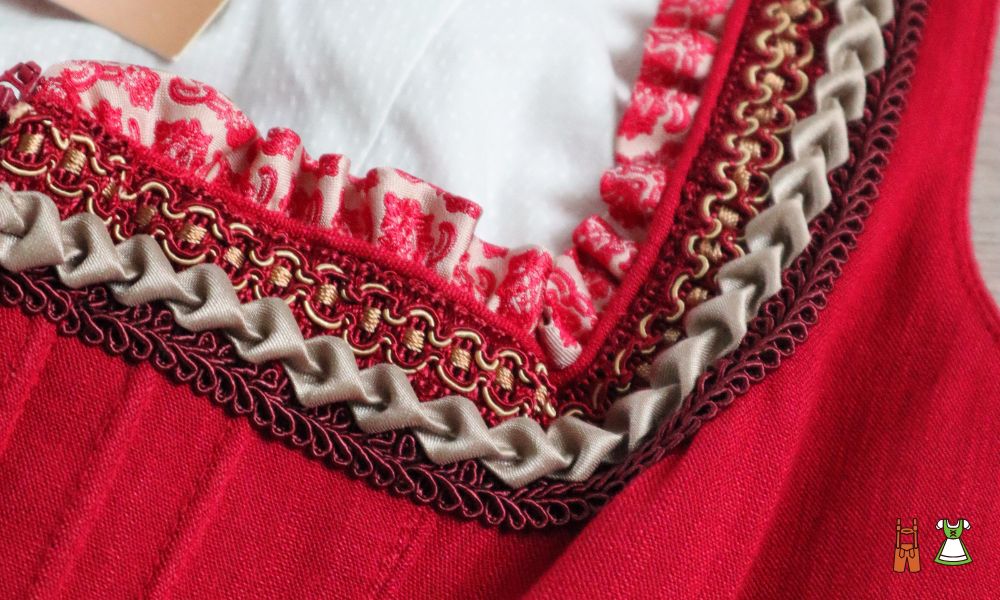the German Traditional Dress Female
German traditional female dress, called Tracht or Volkstracht is a nice reference to the cultural and geographical traditions of Germany, which is exceptionally diverse. This is a classic and unique form which originated in the early nineteenth century when women from rural areas continued to wear plain and functional dresses but decorated them with bright, localistic ornaments.
Consequently, people also perceived the Tracht as a fashion of the German people and positive source of identification with local culture. As promised, in this article, we will briefly discuss the history and development of the German Traditional Dress Female, look through the regional peculiarities of the said garment, and find out how, and to what extent, those vintage pieces capture the present-day hearts of fashion lovers worldwide.

History of the Development of German Traditional Female Costume
German Traditional Dress Female of Germans can be linked with the costumes of the tribes of ancient Germanic who inhabited area which is now called Germany, Some of these tribes were most adept in their arts, and used their talents as influential elements to fashion out particular regional characteristics.
It preserved the variety of the German Traditional Dress Female, which were being influenced by the French, Polish, Austrian, Turkish, Russian etc. The presented examples of influence reflect a very diverse and intertwining history of German people.
Yet, there is a heightened interest in wearing native clothes in the first half the nineteenth century as nationalism and romanticism marked the Germans. Summing up the picturesque and festal attractiveness of region costumes, the masters of art and words described the German people as ethnographically different from others.
This romantic movement reduced the general type of regional tracht to particular regional tracht styles, which demonstrated the features of a certain district in terms of embroidery embellishments, types of fabrics and requisite hues.
Since the beginning of the twentieth century, due to industrialization and the process of urbanization, the prospects for the further existence of the traditional German women’s garment are rather questionable.
Most women in the countryside copied modern fashion trends and rural dressings were replaced with more modern, comfortable, and trendy clothes. But the continuity of tracht was supported people’s cultural organisations, fashion lovers and those devoted artisans who were ready to go extra miles to promote the beauty and importance of these traditional pieces of wear.
Bavarian Tracht:German Traditional Dress Female
Among all the regions of Germany, Bavaria is perhaps the most associated withGerman Traditional Dress Female of Germany. They were tall, dressed in Bavarian Tracht, which was a dress like this, but decorated with a bright color and flowers here and there, embroidery and all sorts of fun accessories. Women’s traditional Bavarian wear consists of a heavy, calf-length flared skirt of light wool or linen, white blouse and an apron.
The ‘Bundfaltentuch’ is a German Traditional Dress Female that can function as a headscarf being highly decorated with embroidery, and being folded in many ways at once can show the woman’s personality. The entire ensemble is accompanied by fine beads which are added on collars, cuffs and bodices; gorgeous shawls, which may be embellished by lace and faint stitchery.
Franconian Tracht:German Traditional Dress Female
The Franconian Tracht is reserved and functional for the largest portion of the franen region in the northeastern part of Bavaria. The Franconian female costumes consist of a long straight, shallow or panelled, linen or cotton skirt, a tight-waisted bodice and a full sleeved blouse with high neck.
Stitched with warps of folk artisanship, colours and laces, and embossed with beautiful appliques the outfit is a riot of vibrant and alive.
Swabian Tracht:German Traditional Dress Female
The Swabian Tracht hails from the south west of Germany and is easily recognizable by the black and red striping. Female Swabian costumes usually consist of a black close-fitting long-sleeved jacket with embroidered in red on the breast, and a full skirt of black wool or linen. To the apron there will add an embroidery, a red headscarf and the long shawl that sometimes is decorated with lace and needlework.
Pomeranian Tracht:German Traditional Dress Female
In Pomeranian region (present day Germany and Poland) Tracht has been known for having unique and very luxurious clothes design. Female Pomeranian costumes are a long, gorgeous skirt of bright fabrics with flowers with strict embroidery or lace.
It is fitted bodice upto knee, long sleeves, collar and cuffs are also embroidered. In a certain way a traditional headscarf, the Doppelbinde, is placed on the hair to encourage areas of difference. Included in this design are things like beaded necklaces, hand fans, and fancy belts that even have fittings.
The Pre-Servationalism Era and Organisation of German Traditional Costume
Over the last few years, the interest in traditional female German costumes has been increased in Germany as well as in other countries. Fashion lovers, historians, and particularly the organizations associated with the fashion world culture of fabricating these clothes have done lots to protect and highlight them. Museums, festivals and education programs were established today to keep German Tracht – for paper, that is to say, for the traditions and patterns – for timelessness.
conclusion:German Traditional Dress Female
Therefore, since silhouette and accessories of German Traditional Dress Female form the motif of regional character and past, the above conclusion can be reached. Male and female, the gorgeous and delicate outfits play some roles in the celebration and preservation of the certain ethnic traditions in present time.
However, one is aware of the German traditional female costume and on the one hand it is recognised and valued by this one; on the other hand this one sees an important mission as the preservation of these values as significant components of our cultural heritage for future generations.
